ISSN ONLINE(2278-8875) PRINT (2320-3765)
ISSN ONLINE(2278-8875) PRINT (2320-3765)
M.Kalaivani1 T.Magesh2
|
| Related article at Pubmed, Scholar Google |
Visit for more related articles at International Journal of Advanced Research in Electrical, Electronics and Instrumentation Engineering
This paper shows the variable speed wind turbine with MPPT controller as fixed speed wind turbine is not suitable for most of the applications. Including a MPPT algorithm in a wind energy system is necessary due to the instantaneous and unpredictable change of the wind speed. The wind turbine drives the Permanent Magnet Synchronous Generator (PMSG). Using a PMSG, very high torque can be achieved at low speeds, no significant losses are generated in the rotor, lower operational noise is achieved and external excitation current is not needed. The Maximum power point tracking is implemented in wind turbine to maintain the output power constant at variable speeds. PI controller is used to calculate the error value as the difference between a measured process variable and a desired set point. The controller attempts to minimize the error. Optimization tool, Genetic Algorithm is implemented in the PI controller for selecting integral gain value.This simulation studies are carried out and analyzed for variable speed wind turbine using the MATLAB/SIMULINK tool.
Keywords |
| Permanent Magnet Synchronous Generator, Wound Field Synchronous Generator, Doubly Fed Induction Generator |
INTRODUCTION |
| Wind turbine technology has improved significantly in the past 20 years. Modern turbines are more reliable, efficient, cost-effective, and the sound of the turbines has been reduced significantly compared to their predecessors. Although many improvements have been made, there needs to be more work done towards improving wind energy grid penetration, reducing the manufacturing and installation cost, and improving turbine efficiency at all wind speeds. The development of new control strategies to maximize power extraction from the wind and increase turbine efficiency will make wind power generation a more reliable source of energy in the future. Wind turbine controllers are very important for the production of energy. A wind turbine should be able to properly generate electricity at different wind speeds so several control systems need to be implemented. Modern wind turbine power control systems depend on the design parameters of the turbine. Nowadays, the use of the variable speed wind turbines is becoming more and more common for several reasons such as: better capture of wind energy, reduction of mechanical stress, and acoustic noise reduction from blades movement. One type of variable speed Wind Turbine system based on a permanent-magnet synchronous generator (PMSG). Using a PMSG, very high torque can be achieved at low speeds, no significant losses are generated in the rotor, lower operational noise is achieved and external excitation current is not needed. |
| Variable speed wind can achieve maximum energy conversion efficiency over a wide range of wind speed. The turbine can continuously adjust its rotational speed according to wind speed. By this, the tip speed ratio can be kept at an optimal value to achieve maximum power conversion efficiency at different wind speeds. During high wind speed, variable speed wind turbine operates in an efficient manner to extract maximum efficiency from wind. It provides increased wind energy output, improved power quality and reduced mechanical stress. |
| Another commercial trend of a wind power generation is in using variable speed wind turbine (VSWT) driving a doubly fed induction generator (DFIG), wound field synchronous generator (WFSG) or permanent magnet synchronous generator (PMSG). The main advantage of variable speed operation is that more energy can be generated for a specific wind speed regime. Although the electrical efficiency decreases due to the losses in the power electronic converters that are essential for variable speed operation, the aerodynamic efficiency increases due to variable speed operation. |
| The aerodynamic efficiency gain can exceed the electrical efficiency loss, resulting in a higher overall efficiency. In addition, the mechanical stress is less because the rotor acts as a flywheel (storing energy temporarily as a buffer), reducing the drive train torque variations. Noise problems are reduced as well because the turbine runs at low speed. The main drawback of variable speed generating systems is that they are more expensive. However, using a variable speed generating system can also give major savings in other subsystems of the turbine such as lighter foundations in offshore applications, limiting the overall cost increase. |
PMSG MODEL |
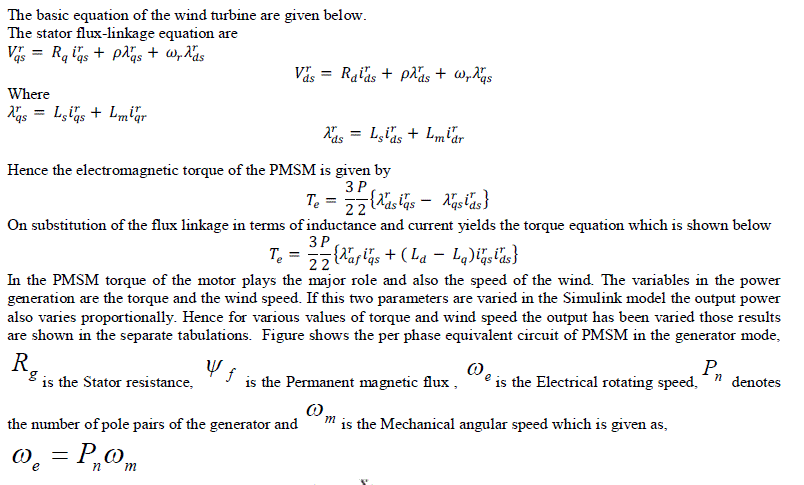 |
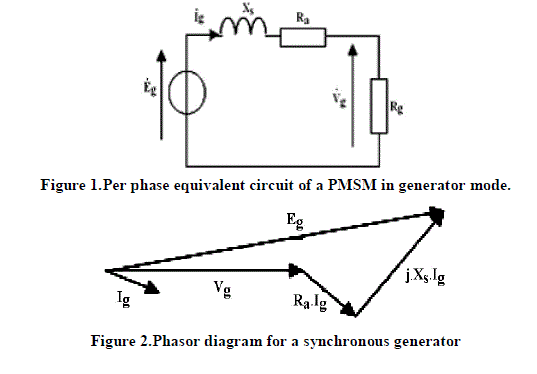 |
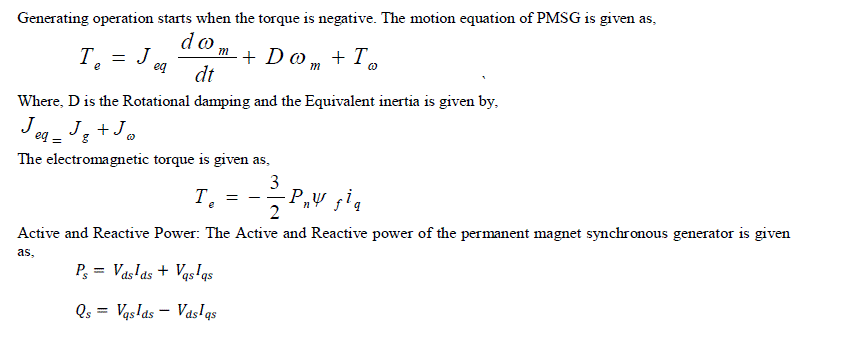 |
| It has to be emphasized that the generator is fully decoupled from the grid by the power electronic converter. Therefore Power factor does not affect the reactive power factor at the grid connection. The expression for the reactive power is of limited interest when studying the grid connection interaction but important when dimensioning the converter. PMSG has been considered as the system which makes it possible to produce electricity from the mechanical energy obtained from the wind. The analysis of the PMSG is done using the dq rotating reference frame. The transformation between the dq rotating reference frame and the abc three phase frame is maintained by park transformation and park’s inverse transformation given below |
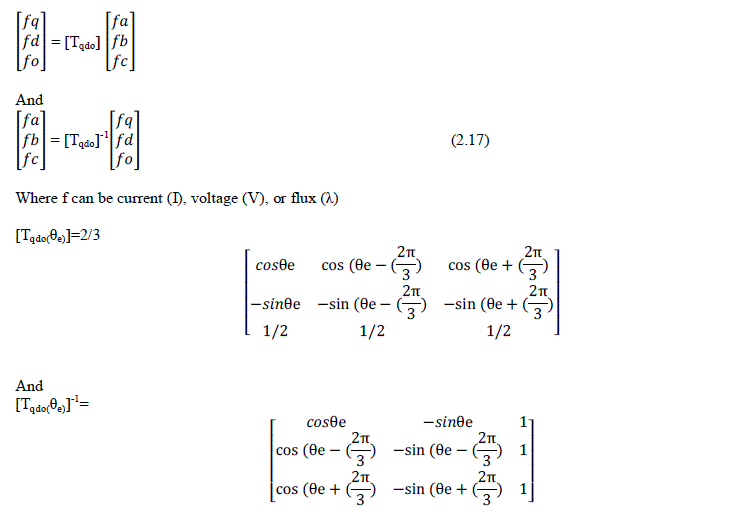 |
| The dynamic electrical model equation for a PMSG in the dq reference frame is given below |
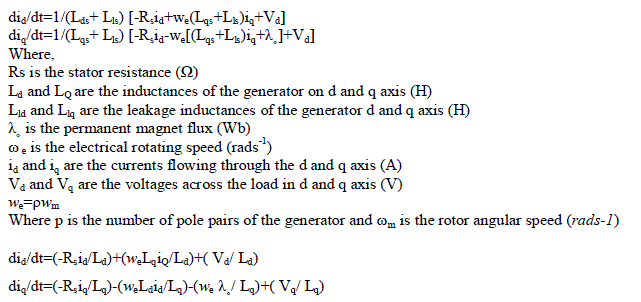 |
III. MPPT OF WIND TURBINE USING PI CONTROLLER AND GA |
| The control method to capture the maximum power from wind turbines in the variable-speed region is called tracking (MPPT) control. The MPPT control is accomplished by tracking the maximum power coefficient (Cpmax) locus on the wind turbine characteristic curve below the rated rotational speed. There are four categories of the MPPT methods in the wind turbine system: power signal feedback (PSF) control, perturbation and observation (P&O) control, tip-speed ratio (TSR) control, and optimal torque control. The PSF controller based on the maximum power curve of the wind turbine needs the rotor speed for yielding the corresponding power reference. |
| The TSR control regulates the rotational speed to keep the optimal TSR. The advantage of this method is a simple implementation; however, the wind speed information should be provided. The performance of the TSR control depends on the anemometer accuracy. Alternatively, an estimated wind speed can be utilized for this method. In the conventional optimal torque control method, the generator torque is controlled to its optimal value corresponding to the maximum power conversion coefficient (Cpmax). In this method, the torque reference is proportional to the square of the rotor speed, and the output power is proportional to the cube of the rotor speed. Since the rotor speed variation is relatively low in the megawatt-class wind turbines, the width of the generator power variation is also narrow. The shortcoming of the optimal torque control is the slow response time for wind speed variations. The aforementioned MPPT methods are based on the steady state characteristics where the effect of the turbine inertia is neglected. Due to the instantaneous changing nature of the wind, it is desirable to determine the one optimal generator speed that ensures maximum energy yield. Therefore, it is essential to include a controller that can track the maximum peak regardless of wind speed. The available MPPT algorithms can be classified as either with or without sensors, as well as according to the techniques used to locate the maximum peak. The optimal torque control (OTC) has been found to be the best MPPT method for wind energy systems due to its simplicity. On the other hand, the perturbation and observation (P&O) method is flexible and simple in implementation, but is less efficient and has difficulties determining the optimum step-size |
PI CONTROLLER |
| The combination of proportional and integral terms is important to increase the speed of the response and also to eliminate the steady state error. The PID controller block is reduced to P and I blocks only as shown in figure. |
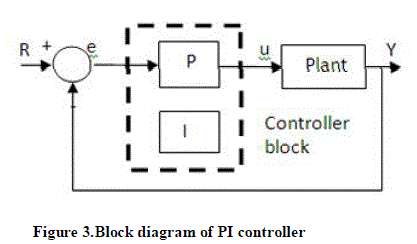 |
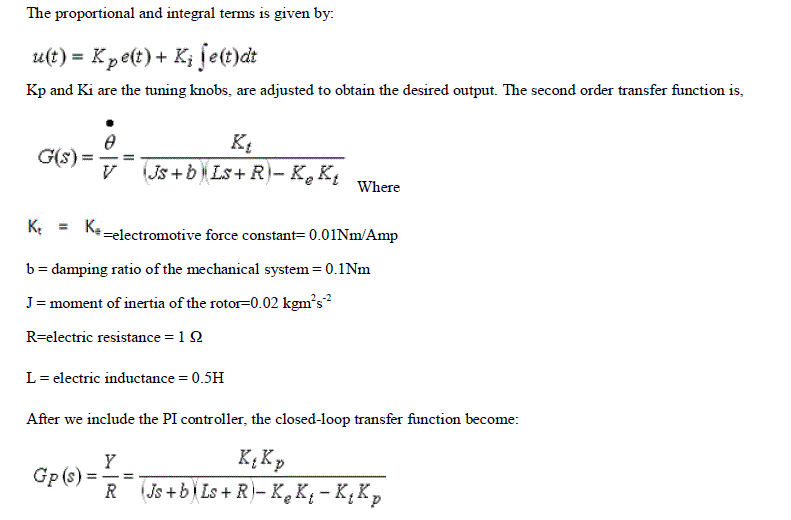 |
| The response yields that as Ki is increasing, the response reaches the steady state faster with steady state error approaching to zero. With PI controller, steady state error can be eliminated with smaller value of Ki (Ki = 0.01), smaller percentage of overshoot (about 13.5%) and larger steady state error (about 0.1). As we increase the gain of Ki, we have larger percentage of overshoot (about 38%) and manage to obtain zero steady error and faster response. P-I-D controller can be introduced in order to reduce the overshoot and to ensure the response converge to the specified design objectives. |
| Proportional + Integral (PI) controllers were developed because of the desirable property that systems with open loop transfer functions have zero steady state error with respect to a step input. |
 |
| Tuning of PI Controllers |
| General approach to tuning: |
| 1. Initially have no integral gain (TI large) |
| 2. Increase KP until get satisfactory response |
| 3. Start to add in integral (decreasing TI) until the steady state errors removed in satisfactory time (may need to reduce KP if the combination becomes oscillatory) |
GENETIC ALGORITHM |
| A genetic algorithm (or short GA) is a search technique used in computing to find true or approximate solutions to optimization and search problems. Genetic algorithms are categorized as global search heuristics. Genetic algorithms are a particular class of evolutionary algorithms that use techniques inspired by evolutionary biology such as inheritance, mutation, selection, and recombination. |
| The basic thought of Genetic algorithm: |
| 1) Randomly producing an original population whose number of individuals is a constant |
| 2) Producing next generation by crossing over and mutation among individuals. |
| 3) Forming the new population of N individuals from the generation of 2) |
| 4) Producing the next population by repeating the step2) and 3) until obtaining the individual which satisfies conditions. |
| Genetic algorithm is search technique. They are adaptive algorithms for finding the global optimum solution for an optimization problem. The population members are strings or chromosomes, which as originally conceived are binary representations of solution vectors. GA undertakes to select subsets (usually pairs) of solutions from a population, called parents, to combine them to produce new solutions called children (or offspring).Rules of combination to yield children are based on the genetic notion of crossover, which consists of interchanging solution values of particular variables, together with occasional operations such as random value changes (called mutations).Children produced by the mating of parents, and that pass a survivability test, are then available to be chosen as parents of the next generation. The choice of parents to be matched in each generation is based on a biased random sampling scheme, which in some (nonstandard) cases is carried out in parallel over separate subpopulations whose best members are periodically exchanged or shared. |
| Advantages |
| A GA has a number of advantages. |
| It can quickly scan a vast solution set. |
| Bad proposals do not affect the end solution negatively as they are simply discarded. |
| The inductive nature of the GA means that it doesn't have to know any rules of the problem - it works by its own internal rules. |
| This is very useful for complex or loosely defined problems |
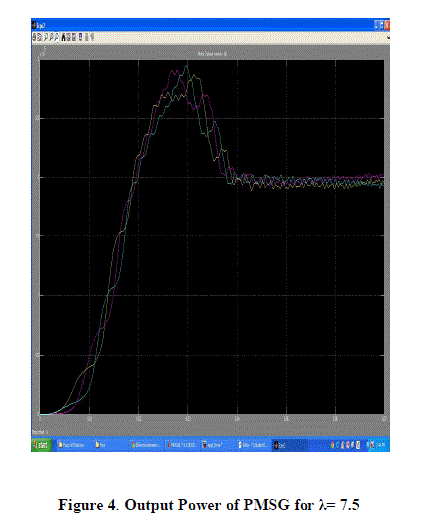 |
| Figure 4.shows the output power waveform of PMSG for the value of tip speed ratio, λ= 7.5 and wind speed V = 12 m/s. It is found that the three phase power gets settled down to 200KW after a specific time and gives constant power. |
| Speed, Torque and Rotor Angle |
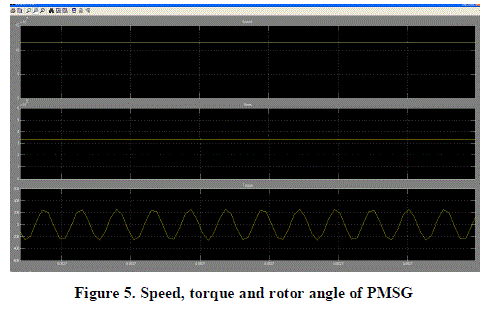 |
| Figure 5.the waveform implies that the speed and torque of PMSG is constant irrespective of the rotor angle . |
| Three Phase Generator Current |
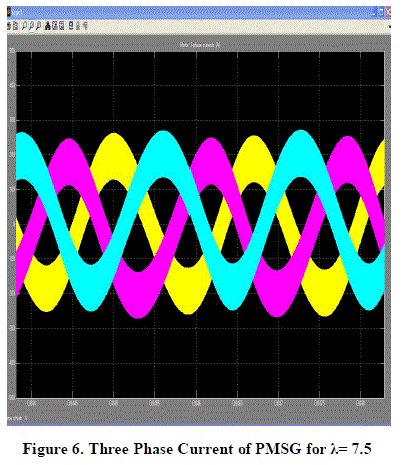 |
| Figure 6.shows the three phase current of PMSG that varies from -200A to 200A for wind speed V = 12 m/s and λ= 7.5. |
| Three Phase Power |
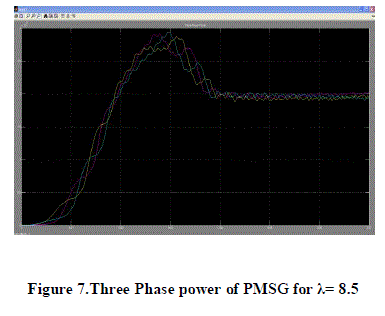 |
| Figure 7.shows the output power waveform of PMSG for value of tip speed ratio, λ= 8.5 and wind speed V = 12 m/s. It is found that the three phase power gets settled down to 200KW after a specific time and gives constant power. |
| Three Phase Generator Current |
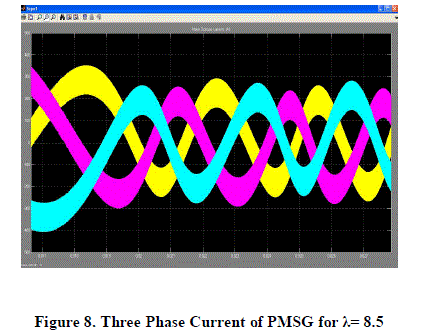 |
| Figure 8.showstshe three phase current of PMSG varies from -400A to 350A for speed of the wind V = 12 m/s and λ= 8.5. |
V.CONCLUSION |
| The presented results show the variable speed wind turbine with MPPT controller. Including a MPPT algorithm in a wind energy system is necessary due to the instantaneous and unpredictable change of the wind speed .The proposed control structure based on PI regulators provides an optimal control solution for PMSG wind turbines. A new MPPT method for the PMSG wind turbine systems hasbeen proposed, where a PI controller is added to thepower controller to improve the dynamic performance of theMPPT control. Also, the proposed method is robust to the parametervariation of the PMSG since the torque feedback controlis not required, different from the conventional optimal torquecontrol scheme. The PI controller reduces the error based on genetic algorithms to obtain optimal gains for controllers It shows that the used optimization strategy based on GA to design the PI controller gains is very efficient in searching for optimal gains thus the power is maintained constant which can feed any load without interruption. The proposed method can be easily extended to include battery charging management or additional Renewable energy Source control, while it can also be modified to control a dc/ac converter in the case of a grid-connected wind-energy-conversion system.In this work, the variable speed wind energy conversion is modeled which has better efficiency than the fixed speed wind energy conversion system. |
References |
|